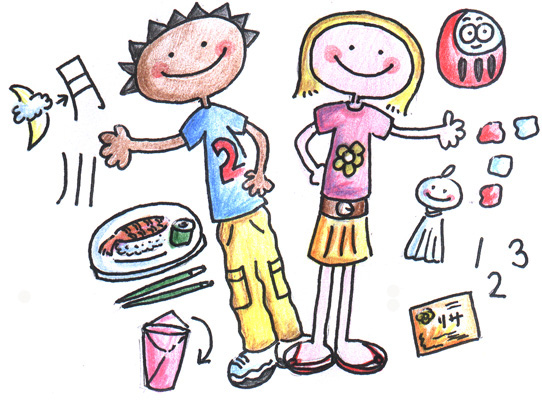Lesson 7
Culture notes Download pdf
Schools
What are Japanese Schools like?
In Japan, you start elementary school at the age of 6 and leave when you are
12. You then go on to junior high school and stay there until you are 15.
Compulsory education ends at the age of 15, although most pupils will go to
senior high school and graduate at the age of 18.
Primary Schools
How many people are there in your class? In Japan, most classes will have
around 30 children in them. Most classrooms are arranged so that all of the
desks face the front and there isn’t usually a carpet area. Children will have
individual desks which can be moved around easily for group work.
Try and draw a bird’s eye view of your own classroom. Keep the drawing
simple and use a ruler to create crisp, sharp lines. Don’t forget to label your
diagram to show the position of windows, doors, the white/black board etc:
School Uniform Do you wear a school uniform? What is it like? Do you have a separate summer and winter uniform? Why do you have to wear one? In Japan, most primary school children can wear their own clothes to school. Is this a good idea? Why? Why not? Discuss with your classmates. Usually, elementary school children will wear a badge which has their name and class written on it. They also have to carry a regulation rucksack and some first grade pupils have to wear a yellow hat. What do you think the reason for this may be?
Draw and label your own school uniform:

In junior and senior high schools in Japan, most pupils have to wear a uniform, like those shown in the pictures below. The two most popular styles are either a blazer and tie (for both boys and girls), or a sailor suit style uniform (girls). Are they similar or different to uniforms in the UK?
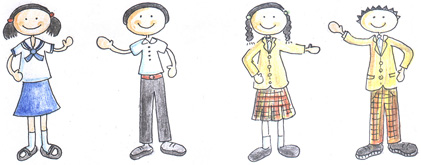
What lessons do pupils learn?
As in the UK, all Japanese elementary school children will learn Maths,
Japanese (like your Literacy hour), Science, PE, History, Geography, ICT and
various other subjects. Japanese children don’t have SATS in primary school,
but they still have to sit regular spelling tests and have maths quizzes too!
Assemblies also take place weekly and on most days there will be a small
class assembly.
Do Japanese children eat school lunches?
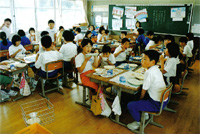 At elementary and junior high
school, most children eat a
compulsory school lunch. It is
called ‘kyushoku’ and usually
consists of a warm meal (either
meat or fish), vegetables, rice or
bread and a drink of milk.
Sometimes Japanese miso soup
is also served. In a few Japanese
schools, it’s also becoming
popular to occasionally serve
foreign meals as a means
widening children’s palates – this helps them to become more aware of food
from other cultures. Unlike most British schools, the lunches are often eaten
in the classroom, and it is the pupils’ job to turn the classroom into a canteen
at lunchtime. However, some schools have a dining hall. Wherever they eat,
children are given different duties to do, such as setting up the tables, serving
the food and cleaning up the mess after lunch. Packaging is collected and
separated so that it can be recycled. It is a real team effort! What are lunches
like in your school? Do you have a school lunch, or a packed lunch?
At elementary and junior high
school, most children eat a
compulsory school lunch. It is
called ‘kyushoku’ and usually
consists of a warm meal (either
meat or fish), vegetables, rice or
bread and a drink of milk.
Sometimes Japanese miso soup
is also served. In a few Japanese
schools, it’s also becoming
popular to occasionally serve
foreign meals as a means
widening children’s palates – this helps them to become more aware of food
from other cultures. Unlike most British schools, the lunches are often eaten
in the classroom, and it is the pupils’ job to turn the classroom into a canteen
at lunchtime. However, some schools have a dining hall. Wherever they eat,
children are given different duties to do, such as setting up the tables, serving
the food and cleaning up the mess after lunch. Packaging is collected and
separated so that it can be recycled. It is a real team effort! What are lunches
like in your school? Do you have a school lunch, or a packed lunch?
What did you have for lunch today? Think carefully about the contents and list below:
Was it a healthy or unhealthy lunch? What could be done to improve it? Would you say that a typical Japanese lunch is more healthy than one eaten in the UK? Why?
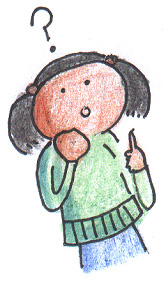 You say that Japanese
children have to clean up
after their lunch. Are there no
dinner ladies?
You say that Japanese
children have to clean up
after their lunch. Are there no
dinner ladies?
Yes, that’s right! In Japan, not only are there no dinner ladies to clear up the mess, but there are also no cleaners! So, after school, each class is responsible for tidying their room so that it’s neat and tidy for the next day. They have rotas to clean communal areas too. This means all the desks are to be wiped, the floor mopped, bins emptied and the board wiped clean! Who cleans your school? Is it a good, or bad idea to have children clear up their own mess? Why?
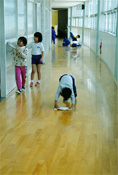
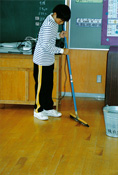
Cleaning time!
How could you become more responsible at your school during:
lesson times
playtime
club activities
Are there any club activities in Japanese schools? Just like the UK, there are many extra curricular club activities, so pupils can join sports teams, art clubs, and various other groups. Most of these activities will take place after school and once you become a member of a club, you take the commitment very seriously. This may mean that you have to practise during weekends and holidays. Are you a member of a club? What do you do? If you are not a member of a club, are there any activities you would like to be involved in?
